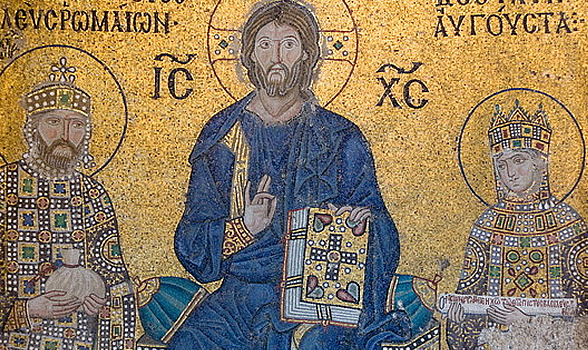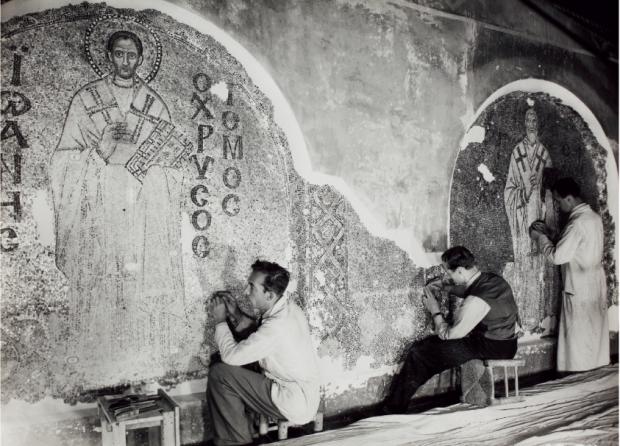Thomas Whittemore has been chipping away plaster walls off for 14 years.
From Time – Jan. 27, 1947, Glory be to God, who hath thought me worthy to accomplish so great a work; 1 have vanquished thee, O Solomon! This was the proud thanksgiving uttered by Justinian the Great at the dedication of the church of St. Sophia (“Divine Wisdom”) in Constantinople 14 centuries ago. Justinian had something to crow about; “compared with the formation of the vilest insect,” as Historian Edward Gibbon pointed out, the church might be dull and insignificant, but the peak of its interior is one of the Highest in the world (180 feet) and as art, St. Sophia doubtless surpassed Solomon’s temple.

Among the church’s beauties, noted Gibbon, were “a variety of ornaments and figures . . . curiously expressed in mosaic; and the images of Christ, of the Virgin, of saints, and of angels, which have been defaced by Turkish fanaticism. . . .” Last week Boston Archeologist Thomas Whittemore returned home from Istanbul, with proof that the conquering Moslems had not been guilty of defacing, only of concealing, St. Sophia’s Christian mosaics. Whittemore, a spry, enthusiastic bachelor of 76, and director of Boston’s well-heeled Byzantine Institute, has been chipping away at the church’s plaster walls off & on for the past 14 years. He had won the approval of Turkey’s late President Kamal Atatürk for the project. At first, because the church was in use as a mosque, Whittemore and his assistants had to take Fridays and Moslem prayer hours off. But in 1935 the Turkish Government made St. Sophia a public monument, and since then work has proceeded on a businesslike 9-to-5 schedule (except for winter months, when the place gets too chilly to work in). Whittemore went right on chipping through the war. Under the plaster he has discovered close to a thousand years of history—in silver, gold, marble, and sparkling glass cubes put together into a parade of saints and influential sinners which stretches from 537 to 1453 A.D., when the Turks came marching in. Among the mosaics already laid bare are portraits of Emperor Leo VI (made about 900 A.D.), Constantine the Great and Justinian II (995), Empress Zoë and Constantine IX (1042), John II Comnenus, Empress Irene, and their son, Alexius (early 12th Century). Whittemore still has years of chipping ahead, and not much of an idea what he will find next. His men work mostly on scaffoldings high up on the walls. They use no chemicals to dissolve the plaster and paint which the Moslems spread over the murals (the Moslem religion forbids pictures of people or animals, as the Jewish forbids graven images). Whittemore has found it safer to flake off inch by inch with “a small steel chisel, [the kind] used in delicately cleaning fossils.” Where they have been freed of plaster, St. Sophia’s walls and vaulting seem to dissolve in color. The mosaics, says Whittemore enthusiastically, meet “the vision as if charioted on a billow of light, each with an appeal as thrilling and compelling and personal as it seems possible to experience. The effect as you move past them has the cumulative power of a rising flood, and they engulf you in the religious enthusiasm of Byzantine conviction. . . . We may say of all [the mosaics] that we are in the presence of [works of] metropolitan masters, compared with which the contemporary mosaics in Italy, for instance, are provincial and derived. We have only to look at extant gth Century mosaics in Roman churches and their feeble treatment to assure ourselves that the fountainhead of the art was at Constantinople.” Throughout the 1,000 years in which they were made, St. Sophia’s mosaics hardly varied in style or excellence. They were made by the best artist of each generation, working in “orchestral” anonymity of the sort that, Scholar Whittemore believes, “life is trying to induce us to return to.”


